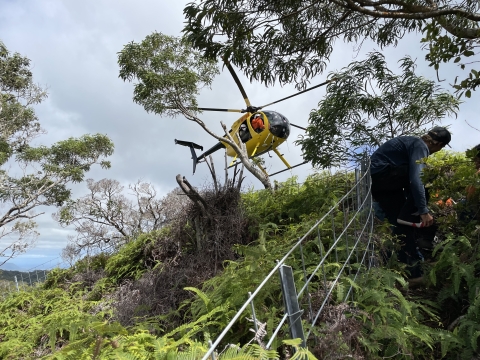In Defense of Our Natural Resources
This story is part of a series called In Defense of Our Natural Resources, highlighting the success of the Army’s partnership with the U.S. Fish and Wildlife Service (USFWS). The Army has dedicated more than $13M in 2023 and 2024 to execute projects restoring habitat, preserving endangered species, and protecting critical ecosystems across 152 installations.
The Army and the U.S. Fish and Wildlife Service are committed to empowering early career professionals to take on these mission critical roles and providing valuable employment experience. This feature highlights the work of Ryan Saito, Biological Science Trainee at the U.S. Army Garrison Oahu.
Spotlight - Ryan Saito
How do you go from chef to conservationist?
After working 13 years in the culinary industry, Ryan Saito (he/him) is now a Federal Pathways Intern in Hawaii, working with Lyon Arboretum, James Campbell National Wildlife Refuge, and the Oahu Army Natural Resources Program.
“I worked in fine dining, and eventually ran my own food truck,” said Saito. “But after I sold it during covid, I decided I didn’t want to go back into food.” It was time for a change, and Ryan knew he wanted to give back and preserve the lands he grew up on.
The need for conservation professionals across the islands is clear – Hawaii is the extinction capitol of the world, having lost more species than any other state. Many students and scientists enter college knowing they want to work in conservation, but what about those transitioning from another career?
Positions can be competitive, but coming into the field later instead of fresh out of college actually proved an advantage for Saito, as he was able to leverage his practical experiences in other areas to excel in his new role.
The U.S Fish and Wildlife Service’s (USFWS) Pathways program allows qualified candidates with a variety of experiences to obtain entry level positions, empowering those who may not come from a scientific background to gain full time employment. In his current Pathways internship, Ryan works across a partnership with the USFWS and the Army to restore native Hawaiian ecosystems.
“I really taught myself to do it all,” said Saito, about working in the culinary industry and running his own food truck. His experience allowed him to troubleshoot problems with tools and equipment when working in the field, making repairs that would otherwise have slowed or halted progress on remote restoration trips.
Plus, knowing how to cook can be a great foot in the door - when the team is trying to decide who’s going on an amazing helicopter backcountry restoration trip, it doesn’t hurt to be the guy who can whip up killer meals for the team at the end of the day. It’s a good selling point.
Additionally, while many early career professionals need time to develop direction and areas of focus, Ryan feels entering the field at this phase in life gave him a clearer picture of his path forward. “I already have a goal, a wide idea of what I want to do long term, and how these positions help it all fit together,” said Saito.
In the long run, Ryan recognizes that it’s all about soil. “It’s daunting how much is unknown about tropical soil,” Saito explains. “So much has been lost to sugarcane plantations and grazing land, so how do we restore it?”
In Partnership with Army Natural Resource Program Oʻahu, part of Ryan’s work is to delicately cultivate seedlings of nearly extinct Hawaiian plants. But often, these plants being grown in good conditions are experiencing huge die off percentages when re-planted in the real world. Ryan knows that the key to their success is to understand the composition of tropical soil, to solve how we can restore it to its former state. Without healthy soil, we can’t have healthy plants or animals.
After his Pathways program, Ryan hopes to continue this research. He will be eligible for conversion into a full time federal employee, and wants to find a position doing meaningful work. “There’s so much work to be done, so much we don’t know, and it all starts with the soil,” said Saito. “And I want to have the biggest impact I can.”





